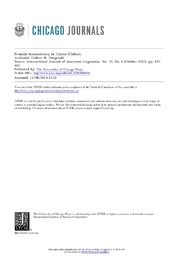
ATTENTION: The works hosted here are being migrated to a new repository that will consolidate resources, improve discoverability, and better show UTA's research impact on the global community. We will update authors as the migration progresses. Please see MavMatrix for more information.
Show simple item record
| dc.contributor.author | Fitzgerald, Colleen M. | |
| dc.date.accessioned | 2014-08-11T17:38:01Z | |
| dc.date.available | 2014-08-11T17:38:01Z | |
| dc.date.issued | 2012 | |
| dc.identifier.citation | Published in International Journal of American Linguistics | en_US |
| dc.identifier.issn | 0020-7071 | |
| dc.identifier.uri | http://hdl.handle.net/10106/24533 | |
| dc.description.abstract | This paper makes a typological contribution by describing a stress system that uses syllabic trochees while also displaying characteristics more typically associated with a quantity-sensitive language. The description comes from Tohono O’odham. The rhythm
of this language is quantity-insensitive and trochaic, although the language also displays characteristics often associated with quantity-sensitivity (i.e., long vowels, gemination).
Examined together, the facts illustrated here demonstrate the prosodic inconsistency of Tohono O’odham: that rhythm and prosodic morphology offer different perspectives on the role played by quantity, and that Tohono O’odham is the first language documented to split its rhythm and prosodic morphology along quantitative lines. | en_US |
| dc.language.iso | en_US | en_US |
| dc.publisher | University of Chicago Press | en_US |
| dc.subject | Tohono O’odham | en_US |
| dc.subject | Prosody | en_US |
| dc.subject | Reduplication | en_US |
| dc.subject | Quantity | en_US |
| dc.subject | Stress | en_US |
| dc.title | Prosodic Inconsistency in Tohono O'odham | en_US |
| dc.type | Article | en_US |
| dc.publisher.department | Department of Linguistics and TESOL, The University of Texas at Arlington | en_US |
| dc.identifier.externalLinkDescription | The original publication is available at Article DOI. | en_US |
| dc.identifier.doi | http://dx.doi.org/10.1086/666930 | |
Files in this item
- Name:
- Fitzgerald_Intl_Journal_Americ ...
- Size:
- 316.1Kb
- Format:
- PDF
- Description:
- PDF
This item appears in the following Collection(s)
Show simple item record


